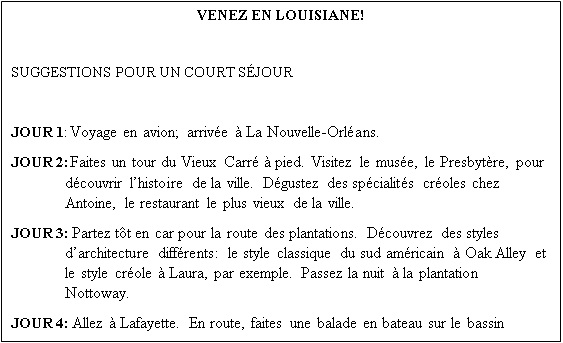What are two of the three cultures tourists will learn about?

What will be an ideal response?
Cajun, Creole, Southern US [any two]
You might also like to view...
Gestures—movements of the hands and arms—are an important type of nonverbal communication. In fact, they are so fundamental that people who have been blind from birth use them. The most common forms of gestures are what social scientists call illustrators—movements that accompany speech and that can't stand alone. Scratching your head when searching for an idea and snapping your fingers
when you find an idea are examples of illustrators that complement verbal messages. Research shows that North Americans use illustrators more often when they are emotionally aroused—trying to explain ideas that are difficult to put into words when they are furious, horrified, very agitated, distressed, or excited. A second type of gestures is emblems—deliberate nonverbal behaviors that have a very precise meaning, known to virtually everyone within a cultural group. For example, we all know that a head nod means "yes," a head shake means "no," a wave means "hello" or "goodbye," and a hand to the ear means "I can't hear you." And almost anybody over the age of seven knows the meaning of a raised finger. A third type of gestures is adaptors—self-touching behaviors. (To make matters confusing, sometimes these behaviors go by the name of manipulators.) Whereas we usually use emblems consciously to express a message, adaptors are usually unconscious. For example, you might fiddle nervously with your hands or click a pen during a high-stress job interview. Research confirms what common sense suggests—that increased use of manipulators is often a sign of discomfort. But not all fidgeting signals uneasiness. People also are likely to use adaptors when relaxed. When they let down their guard (either alone or with friends), they will be more likely to fiddle with an earlobe, twirl a strand of hair, or clean their fingernails. Whether or not the fidgeter is hiding something, observers are likely to interpret an adaptor as a sign of dishonesty. Because not all fidgeters are dishonest, it's important not to jump to conclusions about the meaning of adaptors. The overall organizational pattern of this passage is a. cause and effect. b. comparison. c. classification. d. order of importance.
Ascolta il breve dialogo tra Roberto e Michela e rispondi alle seguenti domande.
Roberto e Michela, un ragazzo padre e una ragazza madre, si incontrano al parco. Michela: Che bel bambino! Quanti anni ha? Roberto: Ha quattro anni. Lui si chiama Carlo e io sono Roberto. E il tuo bambino come si chiama? Michela: Si chiama Simone e ha quattro anni come il tuo. Io sono Michela. Vieni spesso qui al parco? Non ti avevo mai visto prima. Roberto: No, è la prima volta. Non conoscevo questo posto. Mia madre mi ha suggerito di venire qui. E credo che sia stato proprio un buon suggerimento. Vedo che si possono conoscere persone veramente interessanti in questo parco. Michela: Chi hai conosciuto? Roberto: Ma come? Ho conosciuto te.. Non ti sembra abbastanza? Michela: Grazie per il complimento. Ma... e tua moglie? Roberto: Sono solo con Carlo. E tu? Volete venire a mangiare da noi stasera? Pollo e patatine. Michela: Mmmh... il piatto preferito di Simone. A casa mia c’è il minestrone e lui lo odia. Credo proprio di non poter dire di no. Perché a Roberto piace andare al parco? ____________________________________________________________________________________
at 5 o’clock: ____________________________________________
Schreiben Sie diese Zeitausdrücke (time expressions) auf Deutsch.
Venezuela. Complete the statements about Venezuela and its culture. El salto de agua más alto del mundo está en Venezuela y se llama ? __________________________.
Fill in the blank(s) with the appropriate word(s).